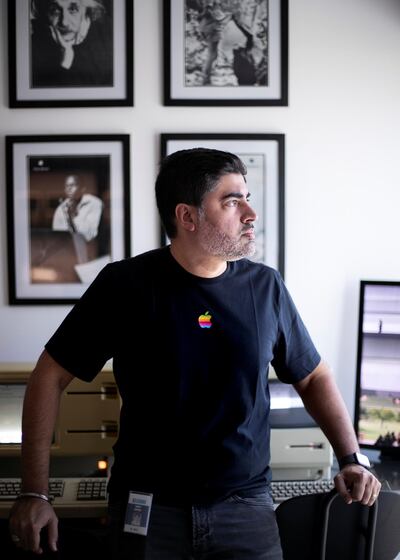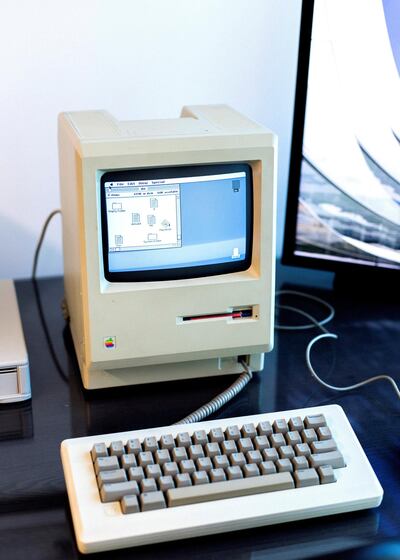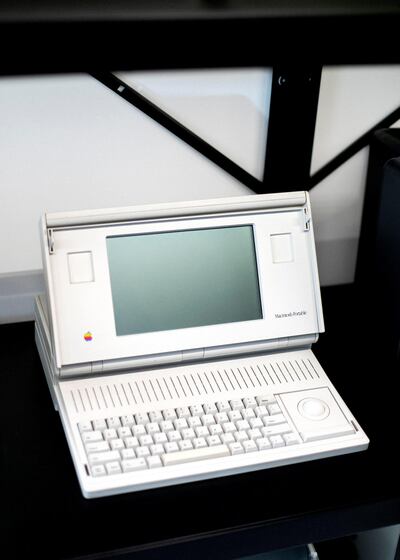Dubai is globally known for its soaring buildings and its futuristic atmosphere, but what many might not realise is that it's also home to one of the world's most valuable private collections of computers offering a glimpse into the past, in particular, the history of Apple products.
“I think it’s a good progression,” says Jimmy Grewal, looking around a room filled with historical Apple devices. “I admire all the people who helped design and build these things."
Grewal soon sits down in front of a green-phosphor monitor ubiquitous to computers of the late seventies and eighties. He starts pounding away on a very old keyboard.
“This is the Apple 1, and it’s an original Apple 1,” says Grewal inside his Dubai office, “It’s one of about 200 they hand assembled inside the [Steve] Jobs home.”
A series of green patterns soon appear on the small screen, and the 40-year-old Apple I still works just as well as the day it was purchased.
“This computer was basically just a logic board…so this was a program that they would run to test and see if there were any problems with the computer.”
Grewal says his interest in computers started in kindergarten. “I attended the American School of Dubai and they were all about Apple,” he says, before walking over to an Apple II, one of several in his collection. “This was given to me by my old computer teacher at the school when he retired.”
He says the school bought the computer in 1978, probably making American School one of the first large Apple customers in the United Arab Emirates. Indeed, on the back of the still-charming beige and slightly bulky casing is a partially worn sticker that reads “Jumeirah American School” (the school's former name).
While class studies helped spark Grewal's interest in computing, he says using Apple products like the Apple II at home propelled him to engage his curiosity to the nth degree. “My interest just grew and grew, and by the time I was in fifth or sixth grade, I was really into it.”
After finishing primary school in the UAE and later graduating from Duke University in the US, Grewal, who was already collecting as many Apple products he could find, ironically took a job at Microsoft.
Although he worked for the software giant’s Macintosh software division, he says his reasoning for starting a career at Microsoft speaks volumes about just how far Apple has come since the mid-1990s, when the pioneering computer maker fell on difficult times and seemed to be on the brink of collapse. “At the time Apple was desperate and it looked like it wasn’t going to be around too much longer, whereas Microsoft was the most valuable company in the world,” he says, noting that Apple’s recent decade of impeccable success causes most to forget how mercurial the company was for several years.
“There’s a number of computers in here that were complete failures,” he adds, reflecting on how many Apple products started out with high hopes but fizzled out into obscurity.
Grewal points to the Apple III on a shelf, a successor to the best-selling and still beloved Apple II. The III, however, was plagued with technical problems and discontinued only a couple of years after introduction.
He also shows off an original Apple Lisa computer in his collection, yet another product that was launched with fanfare but ended with failure.
It was of the first computers sold by Apple to have the now-ubiquitous graphical user interface. It also holds a unique distinction of being named after the daughter of Steve Jobs, even though Jobs denied his paternity to her at the time.
Apple even tried its hand at selling Lisa with a television ad featuring a very young and relatively unknown Kevin Costner. Regardless, the price of the Lisa was too high, and the system was far too slow, among other problems according to Grewal. “There are probably only about twenty original Lisas out there in the world now,” he says.
There’s also a rare (and physically huge) Apple UNIX server in the collection.
Placed on top of the server is another rarity, an Apple Interactive Television Box prototype from 1994. It was never released to the public, but the germ of a good idea was there that would come to fruition many years later as TV and the internet began to converge. “I guess you could say it’s sort of a very early prototype for the Apple TV,” Grewal jokes.
In all, Grewal has at least 70 Apple products on display, and that's not including rare printers and other Apple devices like the ill-fated Newton PDA. The collection is located inside the Dubai offices of ELCOME, the regions largest and oldest technology integrator focused on the maritime industry, where Grewal serves as Executive Director.
Due to the nature of Grewal's work, the museum-like display is not open to the public, but he is actively working on putting more photos and videos online so it can be appreciated around the world.
The latest addition to my collection is a PowerBook 1400cs generously donated by @WPT_Bill. In return I’ve made a small donation to a charitable cause of his choosing. If anyone else has an older Apple computer that they would like to go to a good home please get in touch! pic.twitter.com/FTjmRt78xc
— Jimmy Grewal (@jimmyg) November 6, 2019
He is also flexible to accommodating those with an affinity for technology history. "Depending on the circumstances, I will do my best if someone is really interested and wants to have a look," he says.
It's not just computer hardware, he also collects Apple posters and early advertising literature. He even has a large copy of a rarely-used logo from Apple's earliest days signed by Steve Wozniak. With the 2011 death of Steve Jobs, however, Grewal laments that he was not able to get the former Apple CEO's signature, though he says he did meet Jobs briefly when working at Microsoft.
"I was in two meetings with him, and I don't think he even looked at me in either meeting even though I spoke," he recalls, noting Jobs' focus. "He wasn't into small talk...but I knew people that were his 'direct reports' and they saw the human side of him," Grewal adds.
Grewal makes certain to pay homage to Jobs' attention to detail with his collection.
Need proof? Off to the side of the room he keeps pieces of hardware, manuals and other items in cabinets that have been colour-matched to precisely correspond with the original rainbow-Apple logo.
"I had to figure out what the colour codes were," he frustratingly recalls. "Then luckily I found someone with an old piece of Apple marketing instructions that had them...if those colours were a little bit off, people would know it."
Grewal is also familiar with the incredible details of almost every computer in his collection.
As he points toward what first appears to be yet another Apple II, he explains why it’s different. “This is actually one of the rarest computers I have because it doesn’t have any vents,” he says, pointing out the completely solid casing in contrast to the other Apple II in the room with small gaps to allow for air flow.
He also has several printers including an early Apple Dot Matrix, a rare Apple Scribe thermal printer, and an original LaserWriter.
Grewal says it is important to him for younger generations to appreciate the older hardware, and he plans to eventually go to schools so students can experience first-hand how they’ve evolved over time. In time, he wants his collection to be housed somewhere for the public to see. “I hope that at some point there’s a science or technology museum open in the country where some of this might be more accessible to more people,” he says.
As technology becomes increasingly widespread with the popularity of smartphones, tablets and cloud-computing, it may be surprising to learn the Grewal doesn’t necessarily lament the decreasing prevalence of physical computer hardware. "The fact that computers are becoming ubiquitous is good…it shouldn’t just be an object by itself that people lust over," he says.
That said, he is still collecting, and still taking submissions of old Apple products others might not want anymore.
In fact, during Grewal's interview with The National, he opened a box that had been shipped from Japan.
“This is one that I always wanted,” he said, examining a small laptop. “It’s a 2400c PowerBook.”
When I ask what makes it so special, he smiles.
“It was actually designed and manufactured by IBM’s ThinkPad division for Apple.”
Indeed, the collection is still growing.
Grewal's Apple Product Collection Inventory:
Apple I, II, III
Apple-1
Apple II (Rev. 0)
Apple II (Rev. 3)
Apple II+
Apple II+
Apple III
Apple IIc
Apple IIc
Apple IIc Plus
Apple IIe Enhanced
Apple IIGS (Woz Limited Edition)
Apple IIGS (Woz Limited Edition)
Apple Lisa
Apple Lisa 1
Apple Lisa 2
Macintosh XL
Classic Macintosh
Macintosh 128K
Macintosh 512K
Macintosh Plus
Macintosh SE
Macintosh SE (FDHD)
Macintosh SE/30 (prototype)
Macintosh SE/30
Macintosh Classic II (prototype)
Macintosh Color Classic
Macintosh II
Macintosh IIcx (prototype)
Macintosh IIcx
Macintosh IIci
Macintosh IIfx
Macintosh LC
Macintosh IIsi
Macintosh Quadra 700
Macintosh Quadra 900
Power Macintosh
Power Macintosh 6100
Power Macintosh 8600
Twentieth Anniversary Macintosh
Power Macintosh “Power Express” (prototype)
Power Mac G3/G4/G5
Power Macintosh G3 (mini-tower)
Power Macintosh G3 (blue & white)
Power Mac G4
Power Mac G4 Cube
Power Mac G4 Cube
Power Mac G4 “QuickSilver”
Power Mac G4 “MDD”
Power Mac G5
Power Mac G5
Apple Developer Transition Kit (Mac Pro prototype)
iMac/eMac
iMac G3 (Bondi Blue)
iMac G4
eMac
iMac G5
Laptops
Macintosh Portable
Macintosh PowerBook 100
Macintosh PowerBook 170
Macintosh PowerBook Duo 210
Macintosh PowerBook 5300cs
Macintosh PowerBook 1400cs
Macintosh PowerBook 3400c
Macintosh PowerBook 2400c
iBook G3 (Blueberry)
iBook G3 (Tangerine)
iBook G3 (Graphite)
iBook G3 (Indigo)
iBook G3 (Key Lime)
iBook G4
MacBook (Core 2 Duo - Black)
MacBook (Core 2 Duo - Black)
Servers
Apple Networks Server 500
Power Mac G4 Server
Apple Xserve
Apple Xserve RAID
Handheld Devices
Newton MessagePad
Newton MessagePad 110
Newton MessagePad 120 (transparent case)
Newton MessagePad 130
Newton MessagePad 2000 (2100 upgrade)
eMate 300
iPhone (2G)
iPad





